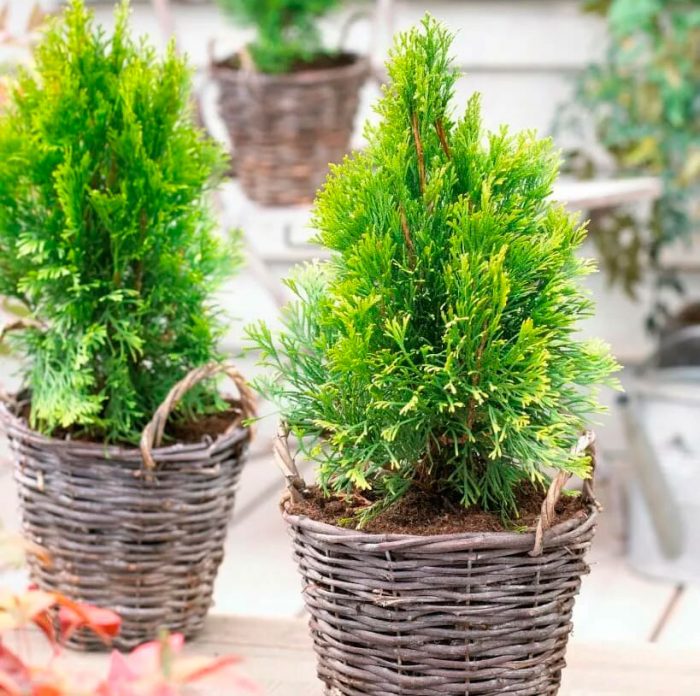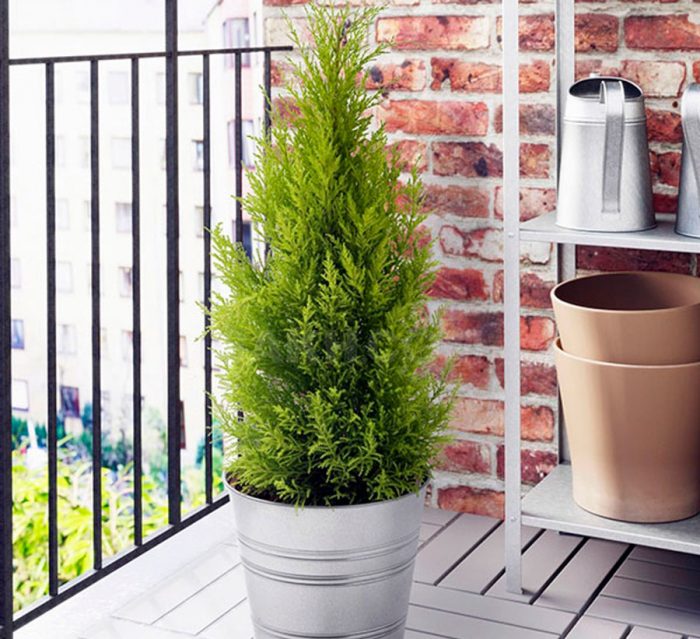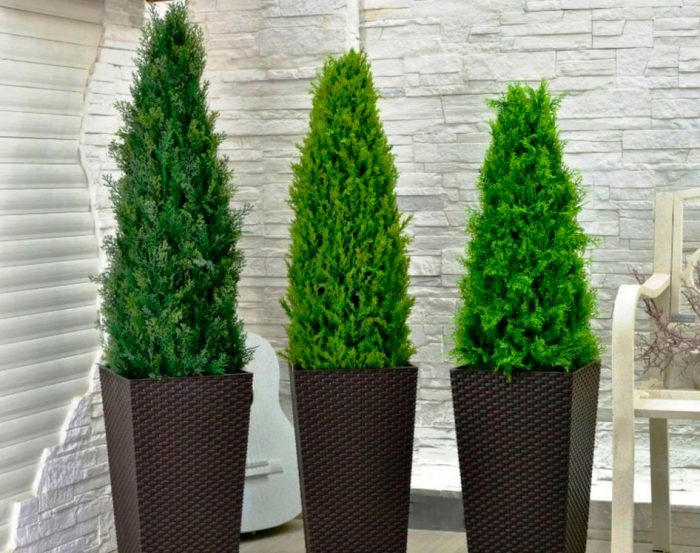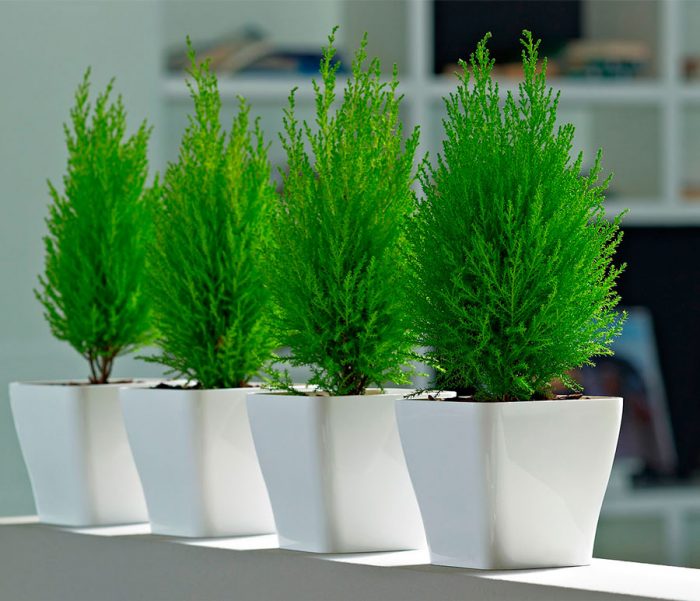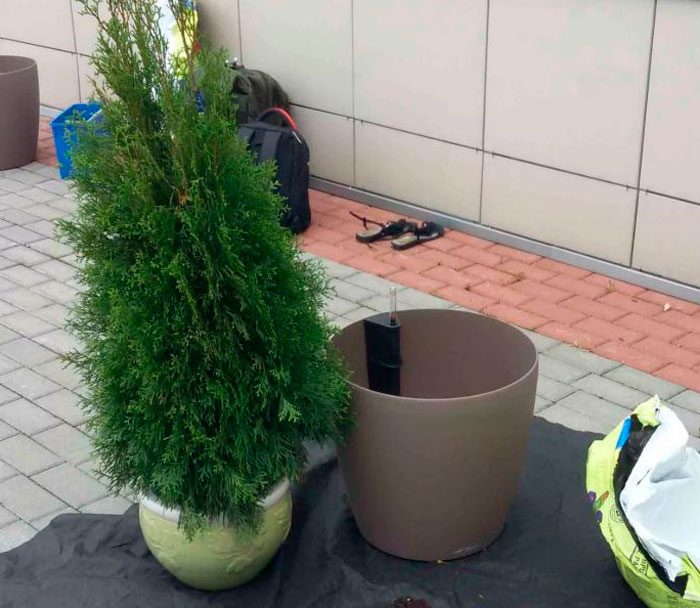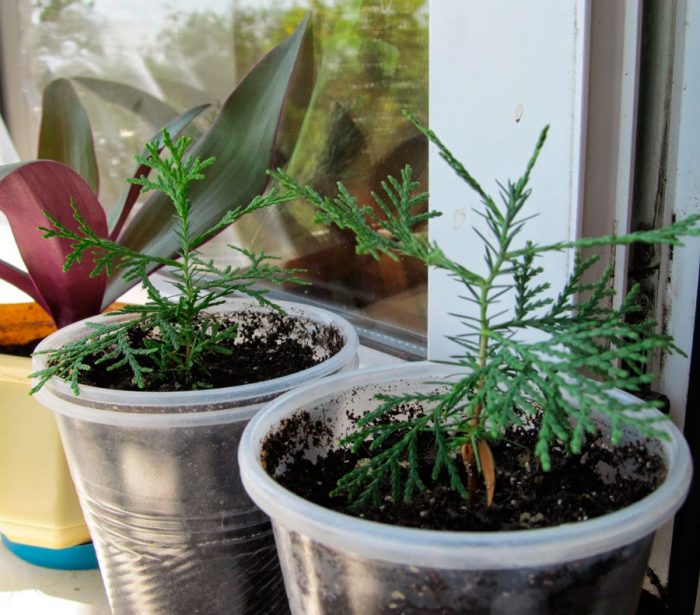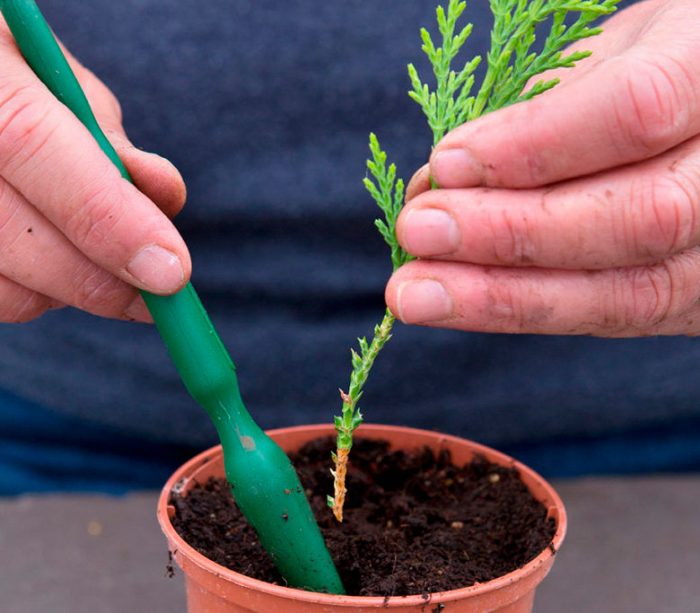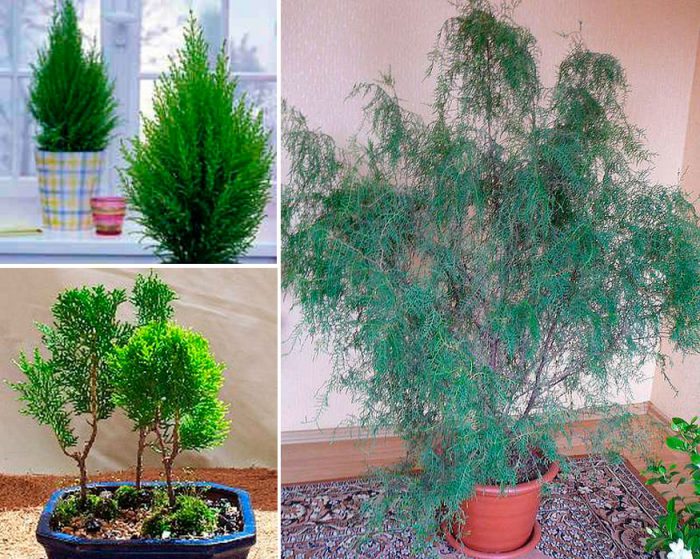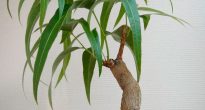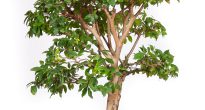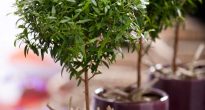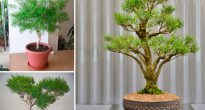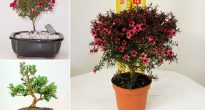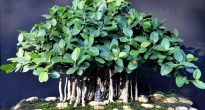Garden thuja is quite widespread in culture, and it is especially popular in landscape design. She is decorated with both squares and parks, and her own garden plots. Thuja is a very effective and compact plant that can purify the air. However, few people know that this culture can be grown at home. In order for the thuja to grow well and not die in unusual conditions for it, it is necessary not only to learn how to properly care for it, but also to choose a suitable species for this.
Content
Thuja features
The coniferous evergreen thuja tree is part of the Cypress family. It has a specific aroma. Cones on this gymnosperm monoecious plant grow both female and male. Pollination is observed in April – May, after which seeds begin to ripen on the plant, which are in ovoid cones. When the boxes are ripe in the autumn, the seeds are shot from them. Thuja is found naturally in Northeast and North America (USA and Canada). The height of this slow-growing plant can vary from 5 to 10 m, it belongs to long-lived plants.
Thuja has very durable wood, which is resistant to decay, which is why the Indians also call it "iron wood". Western is called the one that was brought from America. The pyramidal shape of the western thuja was brought to European territory in the 16th century. In the southern part of Russia, this tree began to be cultivated in the last years of the 18th century. In the Caucasus and Crimea, thuja has become a popular decoration for parks. Tuyu east is widely cultivated in the East as a medicinal and ornamental plant. In the wild, it grows on the mountain slopes of Japan, China and Korea. This plant is also popularly called the “tree of life”. Some experts believe that this is called so thanks to the King of France, while others are sure that this tree is simply a cult tree in the East. For example, thuja in Central Asia was planted in holy places, not far from mosques. In oriental folk medicine, thuja is very widely used as a medicinal plant.
Thuja care at home
In order for thuja to grow normally at home and develop correctly, it requires special growing conditions.
Illumination
Since in nature such a tree grows in North America, preferring cool places, then in indoor conditions it should be protected from scorching direct sunlight. Because of them, burns appear on the foliage, and the needles turn yellow. This tree belongs to shade-tolerant plants. However, if the lighting is too scarce, then its branches will begin to stretch.
In the thuja room, it is better to choose a place that is not too far from the window, especially if it is south. You can put a bush on the windowsill only if it is oriented to the north.
Temperature regime
Pay particular attention to the room temperature, it should change depending on the season and be as suitable as possible for the given plant. In the summer, the indoor temperature can vary from 20 to 30 degrees. In the warm season, the bush can be kept in the room or transferred to fresh air (garden plot or balcony). On the street for the tree, you need to choose a place located in a little shade.
In winter, you should pay special attention to choosing a place suitable for thuja. Remember that she reacts extremely negatively to hot and dry air in the room. The plant feels best in the cold season at a temperature of no more than 15 degrees. A glazed balcony is perfect for wintering a tree. He is not afraid of a slight frost, however, in severe frosts, make sure that the root system of the tree is not overcooled. In this case, the container is wrapped up and placed on a substrate made of cardboard or wood. Also, this plant must be protected from drafts.
Air humidity and watering
Thuja is a drought-resistant plant, and it is also not afraid of excessively low air humidity. It is not necessary to water the bush too often and abundantly, but make sure that the earthen lump in the pot does not dry out completely. Drying of the substrate is especially dangerous during the active growth of the bush and after transplantation. On hot days, watering is carried out 1-2 times in 7 days (the warmer it is in the room, the more often the bush is watered).
With the onset of the cold season, the abundance and amount of watering is reduced. If in the room where the tree is located at this time the temperature is above zero, then poor watering is arranged once every 2-4 weeks. If the air temperature is close to zero, then the thuja is not watered at all until it gets warmer. Water the plant with well-settled water, the temperature of which is close to room temperature. Make sure that no liquid stagnates in the substrate, as this can harm the tree.
Thuja grows normally at any air humidity, and it is not necessary to humidify it from a spray bottle. However, on very hot days, it is still recommended to systematically moisturize the crown of the plant, which will help remove dust from it.
Substrate
To grow such a tree at home, choose a loose soil mixture that is good for moisture and air. Its composition depends on the age of the tree. While the bush is young, it is grown in a soil mixture, which consists of coarse river sand, as well as leafy and coniferous soil (1: 4: 2). A grown tree, which does not require frequent transplants, is planted in a substrate consisting of turf soil, peat and river sand (2: 2: 1). When the tree is already quite mature, it can be planted in ready-made soil mixture for conifers, which is sold in a specialized store.
Suitable capacity
The choice of the size of the container for the room thuja directly depends on the size of the root system. You also need to take into account that the roots of the plant are long, so the capacity should be quite high. If the tree is large, then a stable container should be purchased for it. During transplanting, the new pot should be 20 mm larger than the old one. And when choosing the height of the pot, keep in mind that at its bottom it is imperative to make a drainage layer, the thickness of which is equal to several centimeters.Also pay attention to the bottom of the container, as there must be drainage holes on it.
If for the winter you rearrange the thuja in a place where there may be slight frosts, then pay attention to what material the container is made of. Choose a non-porous material that does not absorb liquid. The container must be frost-resistant and also protect the root system from hypothermia. In the event that thuja hibernates in a relatively warm room (not lower than 10 degrees), then you can not choose a pot so carefully.
Transfer
The tree is transplanted in the spring. As long as the bush is young, its transplant is carried out systematically once a year, and the diameter of the old pot should be 20 mm less than the new one. An adult tree is subjected to this procedure only if necessary, once every few years.
When transplanting thuja, you must adhere to the following rules:
- make a good drainage layer at the bottom of the container;
- water the bush abundantly before and after transplanting;
- the thuja is transplanted by the transshipment method;
- before transplanting an overly large tree, it is pruned;
- if you deepen the root collar a little, additional roots will form on it.
Pruning
Thuja is pruned in the spring. Moreover, at this time, both formative and sanitary pruning is carried out. For prophylaxis, cut off all dried branches. In order to give the crown the shape of a ball or a pyramid, it can not only be cut off, but also pinched off the shoots.
Fertilizer
Home-grown thuja does not need to be fed too often. One feeding in 4 weeks is enough. When choosing a fertilizer, you need to take into account that in the spring time the tree needs a lot of nitrogen, but in the summer months it is fed alternately with phosphorus and potassium fertilizers. There is no need to feed the plant in the autumn-winter period.
Reproduction methods
Thuja, like most houseplants, can be propagated by cuttings and seed.
Growing from seeds
It takes a lot of time, patience, and some knowledge to grow thuja from seeds. You also need to remember that plants grown from seeds do not always retain varietal characteristics. To collect seeds, cones from an adult tree are used. When the buds are fully ripe, they are pruned and stored in a dark and warm place. After cracks appear on them, you can remove the seeds. Before sowing in the substrate, the seed is placed in a moistened cloth for 24 hours. During the day, make sure that the napkin does not dry out.
Fill a small container with soil mixture intended for growing young thuja (see above). After the seeds are evenly distributed over the surface of the soil mixture, they are covered with a layer of sand or sawdust on top. Harvest crops in a place where the air temperature is kept within 20-23 degrees, and the light should be diffused. The first seedlings should appear after 4-6 weeks. The seedling will become a fully formed spectacular tree only after 3-5 years. In this regard, thuja is rarely grown from seeds.
Cuttings
To harvest the cuttings, the side branches are cut. Moreover, you need to cut the cuttings with "heels" (part of the lignified stem), and the length of the cut should be about 10 cm. It is not necessary to water these cuttings. Then they are removed in warmth and do not forget to systematically moisten the soil mixture from a spray bottle. When young leaf plates appear on the segment, this will be a signal that rooting was successful. Next, the cuttings are transferred to a well-ventilated place. After a short time, the rooted segments are planted in permanent containers.
Pests and diseases
Improper care
With room thuja, problems can arise due to pests, fungal diseases, as well as non-compliance with the rules of care. Most often, flower growers are faced with the fact that the leaf plates on the tree turn yellow. This is most often due to the fact that the bush was exposed to scorching sunlight for a long time and burns appeared on its foliage. And it can also happen due to the fact that the root collar of the bush is deeply buried or rises above the surface of the substrate. However, yellowing of foliage in winter is considered a completely natural process, and you should not worry about this.
Diseases
Most often, such a tree is affected by the following fungal diseases: fusarium and cytosporosis. Due to cytosporosis, the thuja bark suffers, black patches appear on its surface. Over time, the disease spreads to the inner layers of the wood, because of which the plant can die without proper treatment.
Due to Fusarium, the needles are colored in a reddish-red hue, and then begin to wither. The root system of the bush also suffers from this disease, because of which it may die. A sick tree is sprayed with a solution of Kartozid or Bordeaux mixture. Thuja is sprayed regularly 1 time in half a month, until she fully recovers.
Pests
This tree can accommodate scale insects, aphids and bark beetles. The aphids that have settled on the needles feed on plant sap, which makes the branches turn yellow. The scale insect loves to settle on seeds and bark. If, when examining the bark, holes are found on it, then this means that the tree has been chosen by bark beetles, which harm it from the inside. To get rid of pests, the bush is sprayed with an insecticidal solution.
Thuja benefits
Thuja can decorate any room, while purifying the air in it. The smell of pine needles helps to normalize sleep and calm down. Also, decoctions are prepared from the foliage, which help with some diseases. And in winter, you can use the thuja instead of a Christmas tree and decorate it for the New Year.


Watch this video on YouTube

